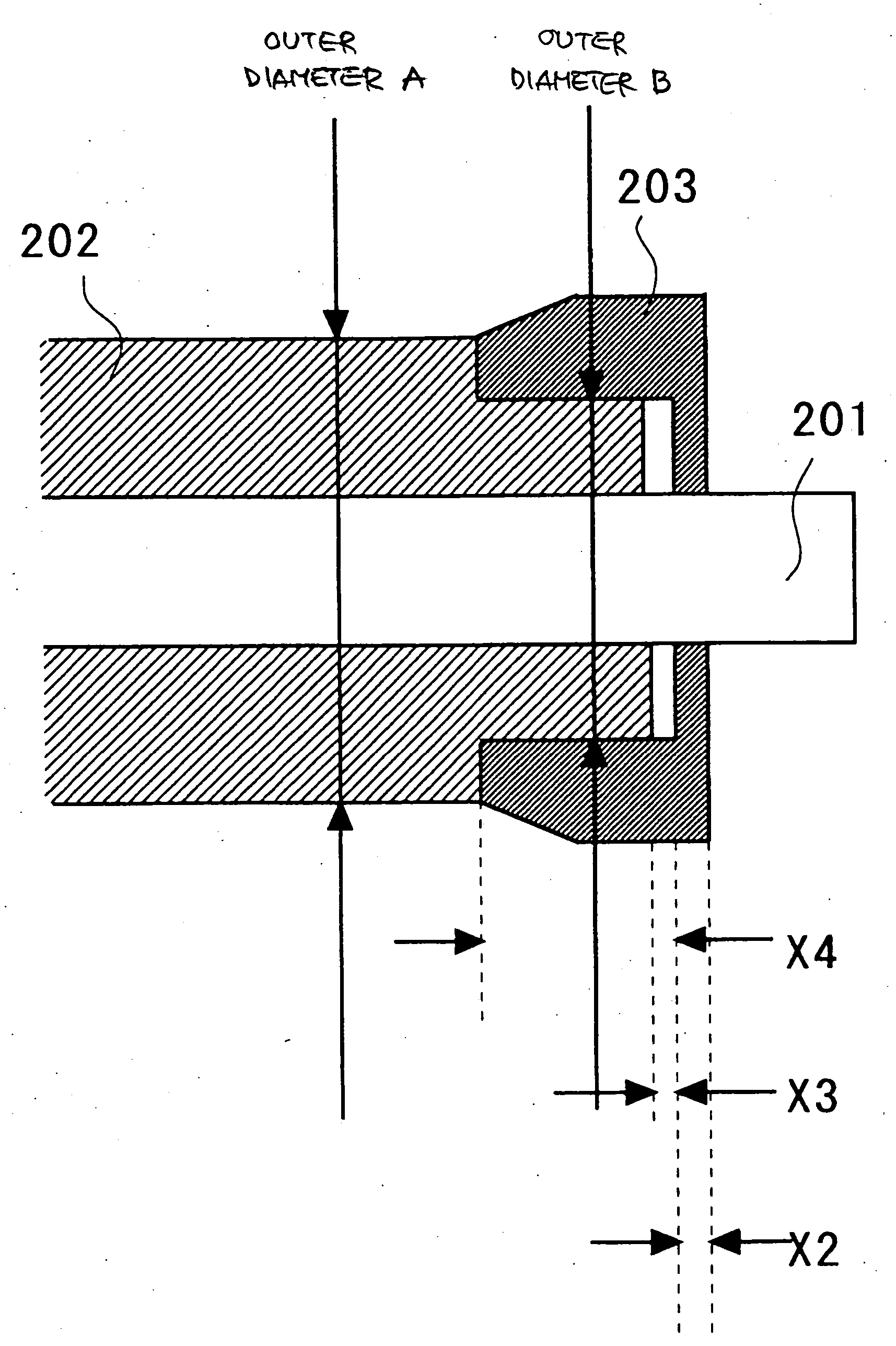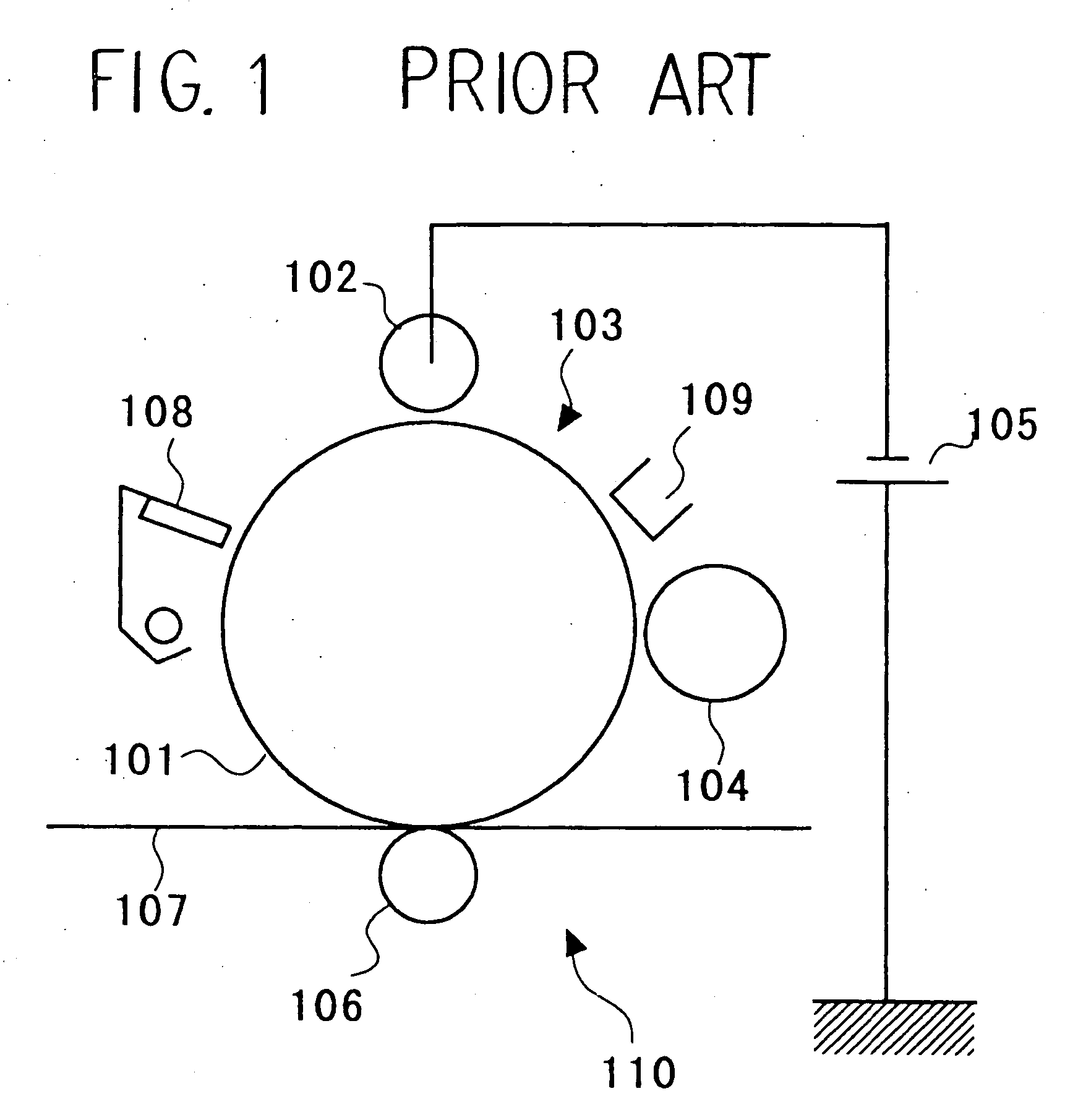Conductive member, and charging roller, process cartridge and image forming apparatus using same
- Summary
- Abstract
- Description
- Claims
- Application Information
AI Technical Summary
Benefits of technology
Problems solved by technology
Method used
Image
Examples
example 1
[0080] A resin composition (intrinsic volume resistance: 2×108 Ωcm) comprising 50 wt % of ABS resin (Denka ABS GR-0500, made by Denki Kagaku Kogyo Co.) and 50 wt % of polyester ester amide (IRGASTAT P18, made by Chiba Specialty Chemicals) was coated by ejection molding to create an electrical resistance adjusting layer 202 on a core axis of stainless steel (outer diameter 8 mm), thereby forming an electrical resistance adjusting layer 202 having an external diameter of 14 mm, and an external diameter in the reduced diameter sections at either end of 11.3 mm. Subsequently, ring-shaped gap maintaining members made of high-density polyethylene resin (Novatech PP HY540, made by Polygem Japan) were fitted and bonded onto the reduced diameter sections on either end of the electrical resistance adjusting layer 202, in order to form gap maintaining members 203.
[0081] Thereupon, cutting was carried out to simultaneously finish the outer diameter (maximum diameter) of the gap maintaining mem...
example 2
[0082] A resin composition (intrinsic volume resistance: 2×108 Ωcm) comprising 50 wt % of ABS resin (Denka ABS GR-0500, made by Denki Kagaku Kogyo Co.) and 50 wt % of polyester ester amide (IRGASTAT P18, made by Chiba Specialty Chemicals) was coated by ejection molding to create an electrical resistance adjusting layer 202 on a core axis of stainless steel (outer diameter 8 mm), thereby forming an electrical resistance adjusting layer 202 having an external diameter of 14 mm, and an external diameter in the reduced diameter sections at either end of 11.1 mm. Subsequently, ring-shaped gap maintaining members made of high-density polyethylene resin (Novatech PP HY540, made by Polygem Japan) were fitted and bonded onto the reduced diameter sections on either end of the electrical resistance adjusting layer 202, in order to form gap maintaining members 203.
[0083] Thereupon, cutting was carried out to simultaneously finish the outer diameter (maximum diameter) of the gap maintaining mem...
example 3
[0084] A resin composition (intrinsic volume resistance: 2×108 Ωcm) comprising 50 wt % of ABS resin (Denka ABS GR-0500, made by Denki Kagaku Kogyo Co.) and 50 wt % of polyester ester amide (IRGASTAT P18, made by Chiba Specialty Chemicals) was coated by ejection molding to create an electrical resistance adjusting layer on a core axis of stainless steel (outer diameter 8 mm), thereby forming an electrical resistance adjusting layer 202 having an external diameter of 14 mm, and an external diameter in the reduced diameter sections at either end of 10.9 mm. Subsequently, ring-shaped gap maintaining members 203 made of high-density polyethylene resin (Novatech PP HY540, made by Polygem Japan) were fitted and bonded onto the reduced diameter sections on either end of the electrical resistance adjusting layer, in order to form gap maintaining members.
[0085] Thereupon, cutting was carried out to simultaneously finish the outer diameter (maximum diameter) of the gap maintaining members to ...
PUM
 Login to View More
Login to View More Abstract
Description
Claims
Application Information
 Login to View More
Login to View More - R&D
- Intellectual Property
- Life Sciences
- Materials
- Tech Scout
- Unparalleled Data Quality
- Higher Quality Content
- 60% Fewer Hallucinations
Browse by: Latest US Patents, China's latest patents, Technical Efficacy Thesaurus, Application Domain, Technology Topic, Popular Technical Reports.
© 2025 PatSnap. All rights reserved.Legal|Privacy policy|Modern Slavery Act Transparency Statement|Sitemap|About US| Contact US: help@patsnap.com



